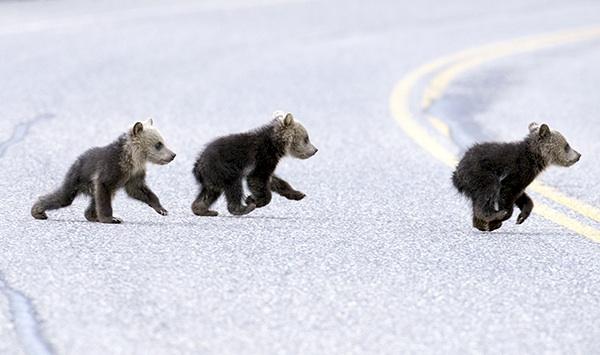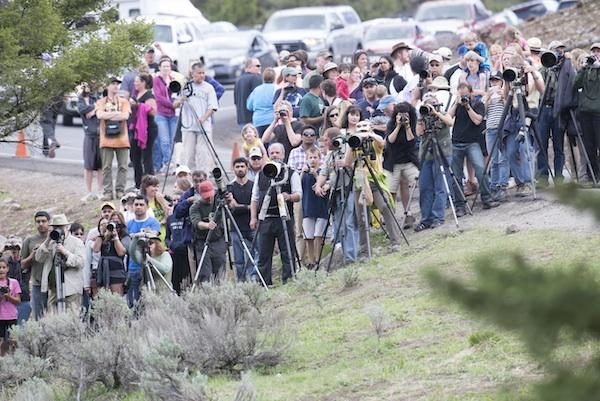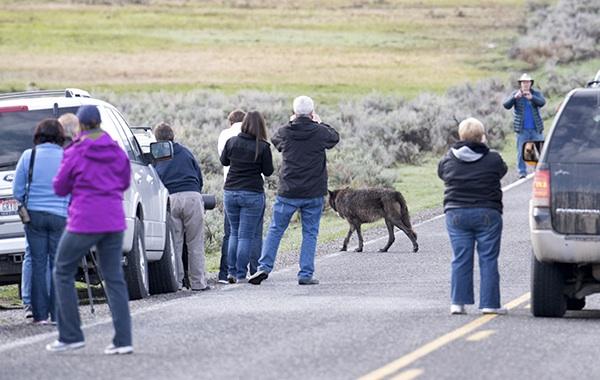
Bear cubs don't always look both ways for oncoming traffic. Sometimes humans should provide that service/Deby Dixon.
What is more important, the animal or the shot?
Nearly every day someone tells me that I have the dream job as a full-time wildlife photographer in Yellowstone National Park, but if they knew that a Dutch photographer nearly punched me out yesterday, when I was trying to assist a black bear in crossing the road on a blind curve, they might think again.
When I arrived in Yellowstone, in October of 2012, to spend the winter learning about wolves, I was a bright-eyed, bushy-tailed photographer who had visions of magnificent shots of the animals as they moved across the landscape.
What I did not count on was that there is much more to wildlife photography then picking up the lens and shooting as they stand still and pose, or run across the sage filled Lamar Valley - much beyond the patience in waiting for the animal to appear, or being in the right position, at the right angle with the right light.
I did not know about the animals themselves and how much they go through while living in a national park. My photographic adventure soon turned to one of advocacy for the wildlife as it relates to many aspects - the hunting of the wildlife, getting too close to the animals and blocking them from moving freely and so much more. Driving cautiously because the animals like to use the roads. My time in Yellowstone, that has now stretched out to nearly two years, has been the greatest, single learning experience of my life.
Not only have I learned that wildlife photography is an extremely competitive and jealous business and my year-around access to Yellowstone does not make me very popular amongst other photographers, but also that the welfare of the animal is more important than the shot.
Yes, I have become an ethical photographer who puts their camera down in favor of helping an animal across the road safely or by removing myself from a situation where the animals are crowded and stressed. And, yes, if need be, I will call upon rangers to come and assist the animals.

Jockeying for that perfect photo/Deby Dixon
Yesterday, someone told me that calling the rangers would only ruin things for myself but what they do not know, is that I have to live with myself. And, so when a black bear sow with three cubs prepares to cross the road on a blind curve, I will alert people to slow down or stop if necessary, in order to keep those animals safe. In the case of yesterday, the cubs did not appear on the road but there was no way to know that when the adult was crossing.
Another wildlife photographer told me that it was okay for them to be close to a sow and three cubs because they were a 'professional wildlife photographer.'
'You are not a professional if you are going to get that close to a sow and three cubs,' I replied. The woman walked off.
The problem for the wildlife is that not only do they have to worry about the visitors with the point and shoot cameras who want to get the same close-up shot as the wildlife photographer, but also the professional photographer who is willing to do anything to any animal or anyone to get the shot.
Meaning that photographers will step in front of and prevent other photographers from getting their shots, while some will use animal calls to lure the bird or wolf to their lens. Others will feed the animals - such as supplying owls with mice or fresh road kill.
I do not believe that the majority of the wildlife photographers, or visitors with point and shoot cameras, intend the animals any harm when they get too close or they feed them, but that they do not fully understand the cause and effect of such actions. I believe this because I did not understand much about the animals and the integrity of wildlife photography until spending nearly every day of the year inside of Yellowstone and watching the problems play out time and time again.
Animal calls make the wildlife easy prey for hunters and poachers and feeding an animal can make it become aggressive towards humans in its attempt to extract food. Being too close to the animals can make them lose their fear of humans, making them easier prey for hunters and some times causing them to be too comfortable around the roads and places where people congregate. These are just a few of the problems related with not giving the animals their wild spaces and allowing them to be free to move about. Animals can be caused to spook and run into the path of a car or in the direction of a predator.
It is our responsibility to alter the animal's behavior as little as possible in order to keep them safe. After all, if the animal is dead our photo ops have ended.
Now, having said all of this, I am not perfect. I, quite often, find myself closer to the animal then is allowed in the national parks, but this is usually due to the animal moving closer to me, rather than me moving closer to them. I tend to read the animals and watch their eyes and behavior for signs of stress. When an animal is grazing peacefully beside the road, they are doing fine, as long as I am not going any closer to them.

How close to wildlife is too close?/Deby Dixon
Just two days ago, I watched as an habituated wolf - one that has been way too comfortable around humans - was hazed by a law enforcement ranger. The beautiful wild wolf has had a habit of coming way too close to people who have watched her in the landscape and she has done so without any signs of aggression whatsoever. I believe that she is just curious about us and wants to check us out, which would end in fatal consequences if she were to leave the park during hunting season.
The law enforcement ranger hit her with a bean bag and then fired a cracker shell between her and the people and road. The wolf took off running for the hills, hopefully a little less curious about humans. For myself, I would rather see this wolf safe then to ever get another close shot of her because she came too close.
So, the next time that you go to photograph an animal, ask yourself, is this animal safe or am I causing it harm. Then, ask yourself, will I enjoy looking at this shot later, knowing the full story about how it came to happen. I have many photos in my folders of times when an animal was photographed under less than ideal circumstances and even though they might be terrific images, the story behind the shot never goes away.



Comments
Deby, I do admit, I admire your work over the years. You're one of the few that has been adament to stand up and speak out for the critters in Yellowstone with your blogs. It's well done work.. You also have used your lens to debunk many myths, and that alone speaks for itself. You aren't going to appease them all with what you do, so don't let the screamers get you down. TRUDGE ON!
Thanks for your comment, Smokies. Perhaps I wasn't clear. This was one example of how difficult it can be sometimes to deal with the public. In the case I told above, the man had a very, very large trailer that would fit into only one slot in the campground. He was enraged that we would not go over there and evict a tent camper from that site.
Rich Harris was polite and patient throughout as he tried to explain why he could not, and would not, comply with the man's demands. The rest of my comment, I think, goes right along with what you are talking about when Congressional (or NPS) leaders cave in to demands for special privileges.
To my simple way of thinking, we just need a few more people like Barry Goldwater to stand up for what's right and decent. (Although I don't remember if I voted for him for President or not . . . . I think I did, but time has taken a toll.)
If I may offer a criticsm in return, I have a problem with many of your comments because you seem to be using an awfully wide brush to paint everyone who wears the Arrowhead. That's unfortunate in my mind. There are countless honest and dedicated people out there. I'm guessing upwards of 95% of all NPS folks fall into that category. If we are going to weed out the rest of them, perhaps it will need to start with weeding out those who bring pressure down upon the service from above in the form of political and fiscal pressures to obtain their goals -- whatever those may be.
Lee,
Thanks for your response. It is obviously well intentioned as was my comment. And I totally accept your critism of my disdain for NPS higher ups. I agree that the majority of NPS employees are fine folks. I should be more clear when speaking of my disdain for the higher ups with whom I have had dealings. Your story reminds me of a time when someone came into the shelter on Mt. Leconte and left their garbage because, "that is what rangers are for." We are all working toward the same goals despite how others may attempt to intentionally mischaracterize things.
" We are all working toward the same goals despite how others may attempt to intentionally mischaracterize things."
I hope so. I've never been to the Smokies and really don't have much of an idea what this whole argument is about, but frankly looking from a distance it appears that there has been a lot of possible mischaracterization, some of it possibly intentional on all sides down there. Strange, isn't it, that it's always the other side that is guilty.
Sometimes it's difficult to remember that it's necessary for individuals to put aside at least some of what they want to obtain in order to do what is best for the majority of all.
I have a hard time believing much of anything written by anyone who makes it a habit to make loud accusations that appear to be based more on opinion than upon fact no matter which side of the discussion they happen to be on.
I think I'm hearing a lot of that from several people here.
I consider myself a National Parks Traveler (since i've been to 33 NPs and over 100 different units in the system), and my goal is to spend time in many of the backcountries of all the NPs (i've already done many large treks in NPs). Yellowstone and the Smokies are the two parks i've spent the most time in. And as far as i'm concerned, this is just a site I like to read since it deals with National Parks in the system. I have personal opinions on National Parks, and I see what I say here as coming from ME and ME only. I'm not a member of a borg, or a group-thinker, or even in the NPS.. I'm an individual.
Problem is a handful of people here are so anti-NPS, and anti-parks and they spend a lot of time here whining about it. It gets old, especially when many of them have a very far outsiders view of parks, and especially seem entirely clueless about the scientific research that goes into them. And sorry, just being a volunteer on occasion, does not in any shape or form mean that you are wearing the Arrowhead... I don't wear an arrowhead either, but I do SEE the park a lot, since i'm in it all the time and get an almost round the clock view of it. 90% of the time being in the park is awesome, but there is that 10% that can as Deby put it above, wear you down.
I dont think many of these people that rant so much here about how bad the NPS is really honestly care about the parks, in general. Many readers on here do, but I could name a few that obviously care less (but I won't start naming names, most of us know who they are). Once you get locked into such hate and driven by that hate to troll sites you don't care about, it controls just about everything you do.
The Smokies are just one unit out of many, so back to this topic at hand, this post by Deby can surely apply to many things i've seen in Cades Cove. Man, where to start. 2 years ago, while trying to film a deer rut (ethically by not displacing the deer, or chasing after them, but just trying to observe mating behavior from a distance), I witnessed 3 guys do a deer drive to push a buck with a large rack that was initially chasing females. They ended up changing the behavior of a buck, and ended up driving it towards an awaiting photog so he could get a closeup shot of the buck as it moved past his lens. Instead of mating with his does, and passing on his genes, instead, a few people ruined what a Naitonal Park should be, which is wildlife habitat. They can't film deer with large racks like this outside of the park, because they all get shot before they make it to this age. I ended up saying something to all 3, and sure enough, they instantly MADE ME the bad guy of the situation because I called them out on what they were doing. I can't tell you how many times i've seen similar things with bears. People chasing bears, people spotting a bear 100's of feet away, then losing their minds and get out running with their cell phones to film it within 5 feet, and then the bear goes running away, and the people still pursue it. It's the wildlifes habitat! So, my mission has been to educate people to this irrational and bad behavior, that the Smokies is NOT A ZOO, but a wildlife preserve and that it's their habitat, and that the visitor should respect wildlife and see it as a preserved habitat.. Other photographers (who are very much local and think that instantly makes them above the rules by keeping distance and changing the behavior of wildlife will run through fields getting shots of fawns while spooking the heck out of them, then posting those pictures on facebook and getting thousands of hits and kudos so that others then think it's ok to do that sort of thing). It's all odd, and all wrong. Sometimes I think the bizarre human behavior is more oddly fascinating than the behavior i'm trying to capture on film. Groups like SFW don't like people like me anyway, so its no skin off my back. You won't win them all over, and if you do, then you're doing something wrong.
Gary,
Noone here "hates" the parks or the Arrowheads that operate them. People here have legitimate different visions of what the parks should be and how they should be run. Some people also see some malfeasence at the top and are "whining" to fix that problem, not to destroy the parks but to make them better.
Having a different vision and wanting to correct corrupt practices doesn't make these bad people and it certainly doesn't mean they hate the parks. When you recognize this and limit yourself to constructive discussion and informed dialogue, maybe you can win them over. And, if you have an open mind, maybe they could even win you over.
Yeah, and i've obviously seen and listened to some of those different "visions". You believe that your pseudoscience is more important and legitimate than actual scientists that work in the field. It's kind of laughable, considering you probably have never worked on or studied any scientific idea in any setting whether it be the corporate world, within government, or at the university level.
Others think mountain biking, atving, and even no limits on backcountry use also don't have an effect on the parks and should be actively promoted as legitimate activities in these national preserves. I don't think I have any inclination to win those people over with those sort of view points, especially when I have observed, along with studied with my own two eyes what a portion of those viewpoints can lead to.
Therein lies the problem.